Cultural Anthropology Assignment 1 & 2: Ethnocentrism, Conflict, Apes
VerifiedAdded on 2022/12/28
|5
|1021
|30
Homework Assignment
AI Summary
This assignment delves into key concepts within cultural anthropology, exploring the nature of ethnic groups, ethnocentrism, and the sources and management of ethnic conflict. It examines the characteristics that define ethnic groups, the pervasive nature of ethnocentrism, and personal reflections on ethnocentric tendencies. The assignment also investigates various sources of ethnic conflict and proposes strategies for conflict resolution. Furthermore, the assignment analyzes anthropomorphism and anthropodenial, contrasting their definitions and exploring B.F. Skinner's behavioral perspective on animal behavior. It discusses the challenges in recognizing similarities between human and ape behavior, the benefits and pitfalls of anthropomorphic perspectives, and the implications of these viewpoints. The document draws upon cited works to support its arguments and analysis.
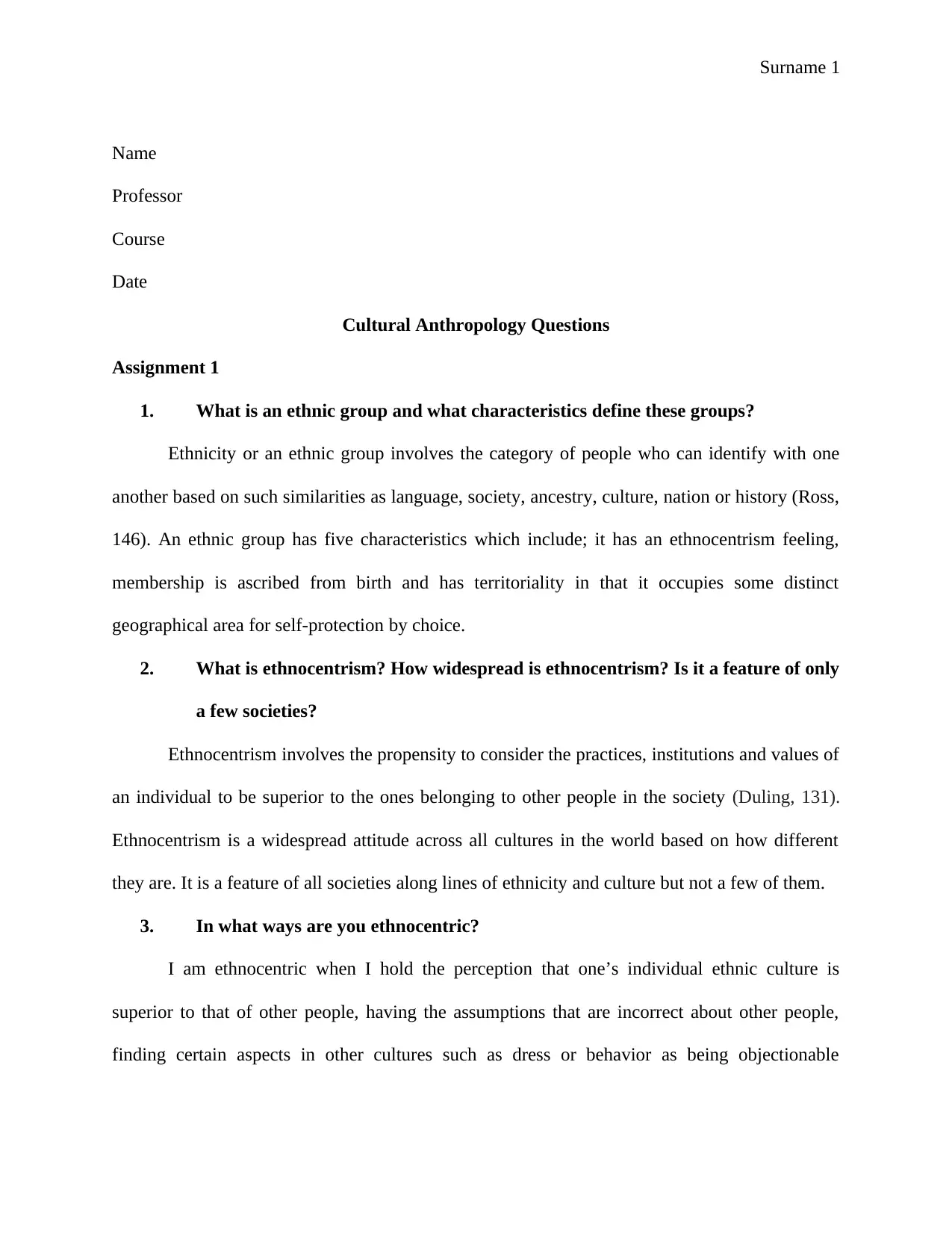
Surname 1
Name
Professor
Course
Date
Cultural Anthropology Questions
Assignment 1
1. What is an ethnic group and what characteristics define these groups?
Ethnicity or an ethnic group involves the category of people who can identify with one
another based on such similarities as language, society, ancestry, culture, nation or history (Ross,
146). An ethnic group has five characteristics which include; it has an ethnocentrism feeling,
membership is ascribed from birth and has territoriality in that it occupies some distinct
geographical area for self-protection by choice.
2. What is ethnocentrism? How widespread is ethnocentrism? Is it a feature of only
a few societies?
Ethnocentrism involves the propensity to consider the practices, institutions and values of
an individual to be superior to the ones belonging to other people in the society (Duling, 131).
Ethnocentrism is a widespread attitude across all cultures in the world based on how different
they are. It is a feature of all societies along lines of ethnicity and culture but not a few of them.
3. In what ways are you ethnocentric?
I am ethnocentric when I hold the perception that one’s individual ethnic culture is
superior to that of other people, having the assumptions that are incorrect about other people,
finding certain aspects in other cultures such as dress or behavior as being objectionable
Name
Professor
Course
Date
Cultural Anthropology Questions
Assignment 1
1. What is an ethnic group and what characteristics define these groups?
Ethnicity or an ethnic group involves the category of people who can identify with one
another based on such similarities as language, society, ancestry, culture, nation or history (Ross,
146). An ethnic group has five characteristics which include; it has an ethnocentrism feeling,
membership is ascribed from birth and has territoriality in that it occupies some distinct
geographical area for self-protection by choice.
2. What is ethnocentrism? How widespread is ethnocentrism? Is it a feature of only
a few societies?
Ethnocentrism involves the propensity to consider the practices, institutions and values of
an individual to be superior to the ones belonging to other people in the society (Duling, 131).
Ethnocentrism is a widespread attitude across all cultures in the world based on how different
they are. It is a feature of all societies along lines of ethnicity and culture but not a few of them.
3. In what ways are you ethnocentric?
I am ethnocentric when I hold the perception that one’s individual ethnic culture is
superior to that of other people, having the assumptions that are incorrect about other people,
finding certain aspects in other cultures such as dress or behavior as being objectionable
Paraphrase This Document
Need a fresh take? Get an instant paraphrase of this document with our AI Paraphraser
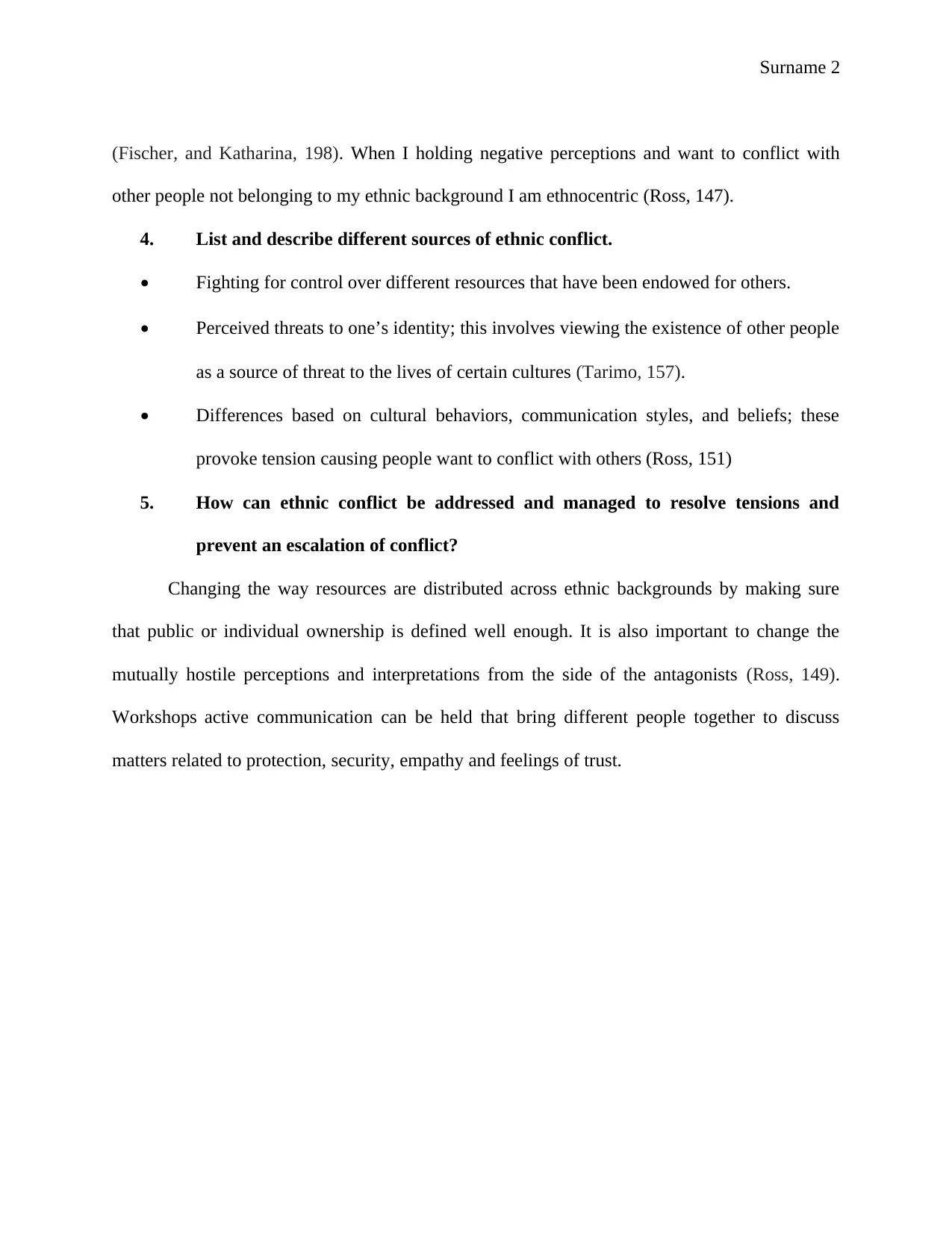
Surname 2
(Fischer, and Katharina, 198). When I holding negative perceptions and want to conflict with
other people not belonging to my ethnic background I am ethnocentric (Ross, 147).
4. List and describe different sources of ethnic conflict.
• Fighting for control over different resources that have been endowed for others.
• Perceived threats to one’s identity; this involves viewing the existence of other people
as a source of threat to the lives of certain cultures (Tarimo, 157).
• Differences based on cultural behaviors, communication styles, and beliefs; these
provoke tension causing people want to conflict with others (Ross, 151)
5. How can ethnic conflict be addressed and managed to resolve tensions and
prevent an escalation of conflict?
Changing the way resources are distributed across ethnic backgrounds by making sure
that public or individual ownership is defined well enough. It is also important to change the
mutually hostile perceptions and interpretations from the side of the antagonists (Ross, 149).
Workshops active communication can be held that bring different people together to discuss
matters related to protection, security, empathy and feelings of trust.
(Fischer, and Katharina, 198). When I holding negative perceptions and want to conflict with
other people not belonging to my ethnic background I am ethnocentric (Ross, 147).
4. List and describe different sources of ethnic conflict.
• Fighting for control over different resources that have been endowed for others.
• Perceived threats to one’s identity; this involves viewing the existence of other people
as a source of threat to the lives of certain cultures (Tarimo, 157).
• Differences based on cultural behaviors, communication styles, and beliefs; these
provoke tension causing people want to conflict with others (Ross, 151)
5. How can ethnic conflict be addressed and managed to resolve tensions and
prevent an escalation of conflict?
Changing the way resources are distributed across ethnic backgrounds by making sure
that public or individual ownership is defined well enough. It is also important to change the
mutually hostile perceptions and interpretations from the side of the antagonists (Ross, 149).
Workshops active communication can be held that bring different people together to discuss
matters related to protection, security, empathy and feelings of trust.
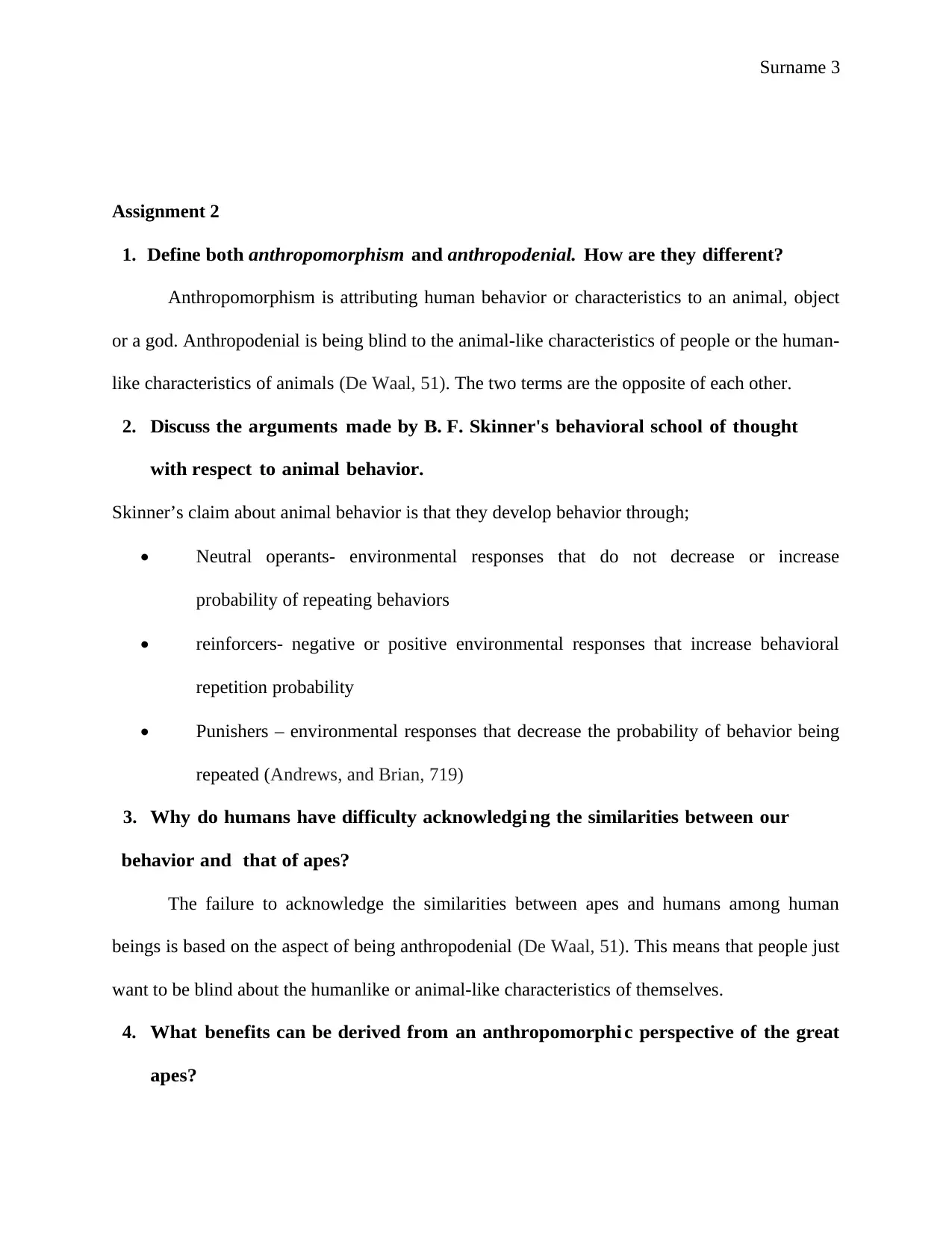
Surname 3
Assignment 2
1. Define both anthropomorphism and anthropodenial. How are they different?
Anthropomorphism is attributing human behavior or characteristics to an animal, object
or a god. Anthropodenial is being blind to the animal-like characteristics of people or the human-
like characteristics of animals (De Waal, 51). The two terms are the opposite of each other.
2. Discuss the arguments made by B. F. Skinner's behavioral school of thought
with respect to animal behavior.
Skinner’s claim about animal behavior is that they develop behavior through;
• Neutral operants- environmental responses that do not decrease or increase
probability of repeating behaviors
• reinforcers- negative or positive environmental responses that increase behavioral
repetition probability
• Punishers – environmental responses that decrease the probability of behavior being
repeated (Andrews, and Brian, 719)
3. Why do humans have difficulty acknowledgi ng the similarities between our
behavior and that of apes?
The failure to acknowledge the similarities between apes and humans among human
beings is based on the aspect of being anthropodenial (De Waal, 51). This means that people just
want to be blind about the humanlike or animal-like characteristics of themselves.
4. What benefits can be derived from an anthropomorphi c perspective of the great
apes?
Assignment 2
1. Define both anthropomorphism and anthropodenial. How are they different?
Anthropomorphism is attributing human behavior or characteristics to an animal, object
or a god. Anthropodenial is being blind to the animal-like characteristics of people or the human-
like characteristics of animals (De Waal, 51). The two terms are the opposite of each other.
2. Discuss the arguments made by B. F. Skinner's behavioral school of thought
with respect to animal behavior.
Skinner’s claim about animal behavior is that they develop behavior through;
• Neutral operants- environmental responses that do not decrease or increase
probability of repeating behaviors
• reinforcers- negative or positive environmental responses that increase behavioral
repetition probability
• Punishers – environmental responses that decrease the probability of behavior being
repeated (Andrews, and Brian, 719)
3. Why do humans have difficulty acknowledgi ng the similarities between our
behavior and that of apes?
The failure to acknowledge the similarities between apes and humans among human
beings is based on the aspect of being anthropodenial (De Waal, 51). This means that people just
want to be blind about the humanlike or animal-like characteristics of themselves.
4. What benefits can be derived from an anthropomorphi c perspective of the great
apes?
⊘ This is a preview!⊘
Do you want full access?
Subscribe today to unlock all pages.

Trusted by 1+ million students worldwide
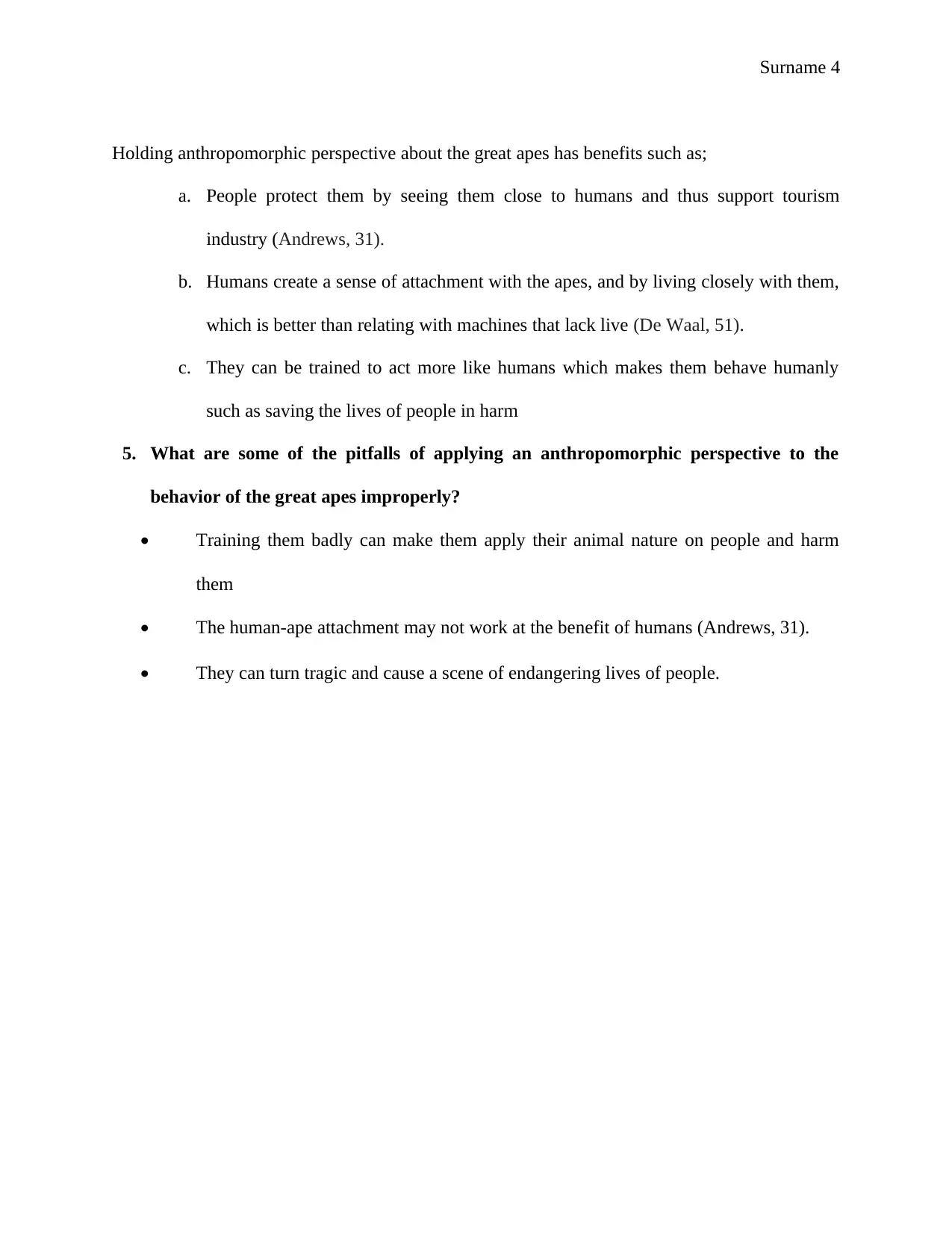
Surname 4
Holding anthropomorphic perspective about the great apes has benefits such as;
a. People protect them by seeing them close to humans and thus support tourism
industry (Andrews, 31).
b. Humans create a sense of attachment with the apes, and by living closely with them,
which is better than relating with machines that lack live (De Waal, 51).
c. They can be trained to act more like humans which makes them behave humanly
such as saving the lives of people in harm
5. What are some of the pitfalls of applying an anthropomorphic perspective to the
behavior of the great apes improperly?
• Training them badly can make them apply their animal nature on people and harm
them
• The human-ape attachment may not work at the benefit of humans (Andrews, 31).
• They can turn tragic and cause a scene of endangering lives of people.
Holding anthropomorphic perspective about the great apes has benefits such as;
a. People protect them by seeing them close to humans and thus support tourism
industry (Andrews, 31).
b. Humans create a sense of attachment with the apes, and by living closely with them,
which is better than relating with machines that lack live (De Waal, 51).
c. They can be trained to act more like humans which makes them behave humanly
such as saving the lives of people in harm
5. What are some of the pitfalls of applying an anthropomorphic perspective to the
behavior of the great apes improperly?
• Training them badly can make them apply their animal nature on people and harm
them
• The human-ape attachment may not work at the benefit of humans (Andrews, 31).
• They can turn tragic and cause a scene of endangering lives of people.
Paraphrase This Document
Need a fresh take? Get an instant paraphrase of this document with our AI Paraphraser
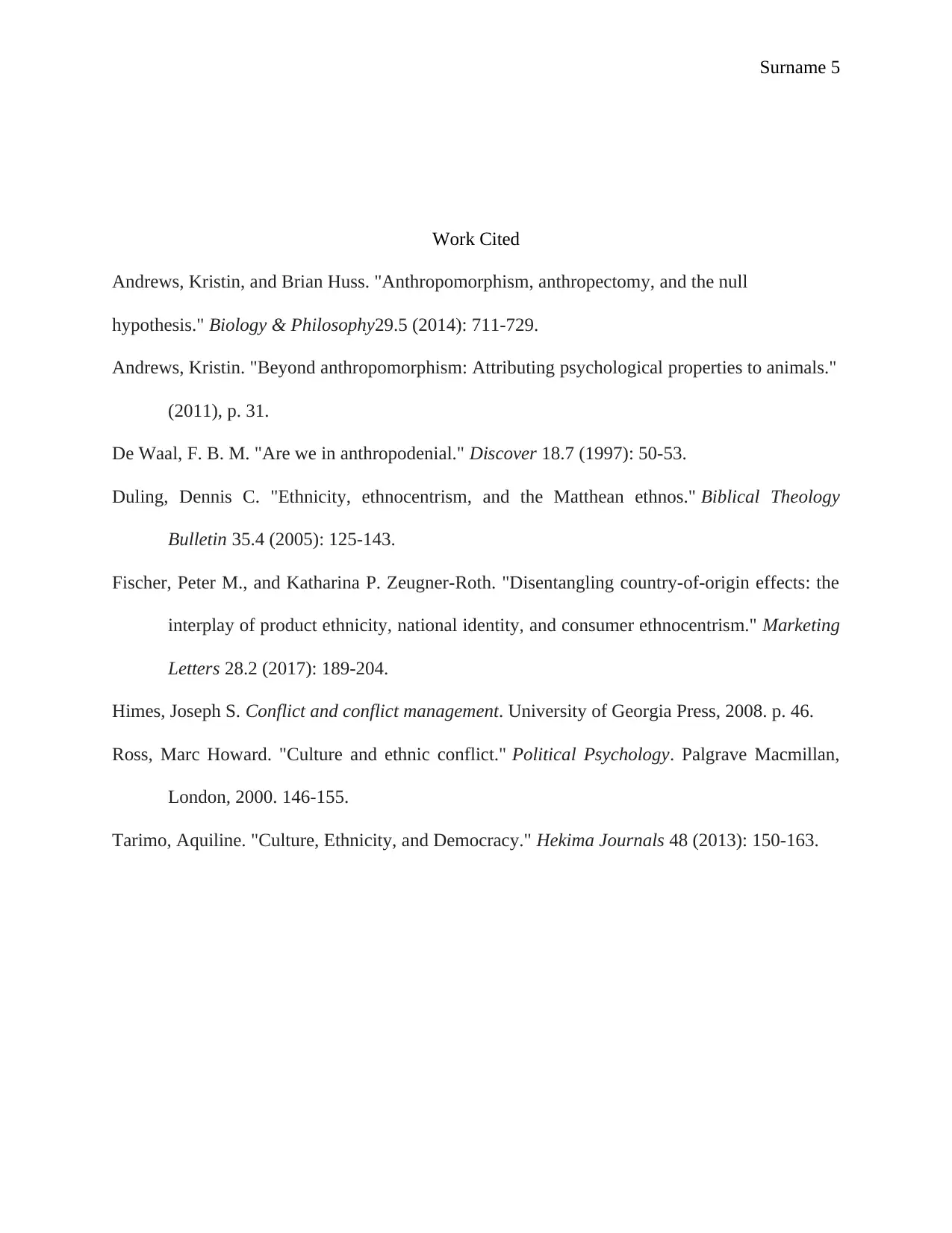
Surname 5
Work Cited
Andrews, Kristin, and Brian Huss. "Anthropomorphism, anthropectomy, and the null
hypothesis." Biology & Philosophy29.5 (2014): 711-729.
Andrews, Kristin. "Beyond anthropomorphism: Attributing psychological properties to animals."
(2011), p. 31.
De Waal, F. B. M. "Are we in anthropodenial." Discover 18.7 (1997): 50-53.
Duling, Dennis C. "Ethnicity, ethnocentrism, and the Matthean ethnos." Biblical Theology
Bulletin 35.4 (2005): 125-143.
Fischer, Peter M., and Katharina P. Zeugner-Roth. "Disentangling country-of-origin effects: the
interplay of product ethnicity, national identity, and consumer ethnocentrism." Marketing
Letters 28.2 (2017): 189-204.
Himes, Joseph S. Conflict and conflict management. University of Georgia Press, 2008. p. 46.
Ross, Marc Howard. "Culture and ethnic conflict." Political Psychology. Palgrave Macmillan,
London, 2000. 146-155.
Tarimo, Aquiline. "Culture, Ethnicity, and Democracy." Hekima Journals 48 (2013): 150-163.
Work Cited
Andrews, Kristin, and Brian Huss. "Anthropomorphism, anthropectomy, and the null
hypothesis." Biology & Philosophy29.5 (2014): 711-729.
Andrews, Kristin. "Beyond anthropomorphism: Attributing psychological properties to animals."
(2011), p. 31.
De Waal, F. B. M. "Are we in anthropodenial." Discover 18.7 (1997): 50-53.
Duling, Dennis C. "Ethnicity, ethnocentrism, and the Matthean ethnos." Biblical Theology
Bulletin 35.4 (2005): 125-143.
Fischer, Peter M., and Katharina P. Zeugner-Roth. "Disentangling country-of-origin effects: the
interplay of product ethnicity, national identity, and consumer ethnocentrism." Marketing
Letters 28.2 (2017): 189-204.
Himes, Joseph S. Conflict and conflict management. University of Georgia Press, 2008. p. 46.
Ross, Marc Howard. "Culture and ethnic conflict." Political Psychology. Palgrave Macmillan,
London, 2000. 146-155.
Tarimo, Aquiline. "Culture, Ethnicity, and Democracy." Hekima Journals 48 (2013): 150-163.
1 out of 5
Related Documents
Your All-in-One AI-Powered Toolkit for Academic Success.
+13062052269
info@desklib.com
Available 24*7 on WhatsApp / Email
![[object Object]](/_next/static/media/star-bottom.7253800d.svg)
Unlock your academic potential
Copyright © 2020–2025 A2Z Services. All Rights Reserved. Developed and managed by ZUCOL.





